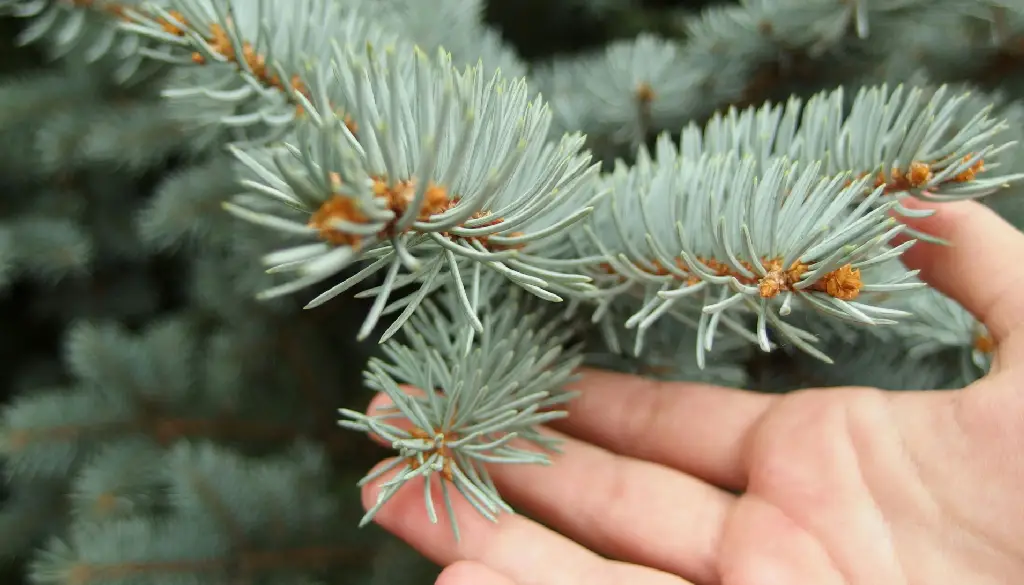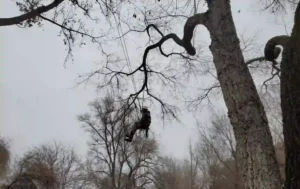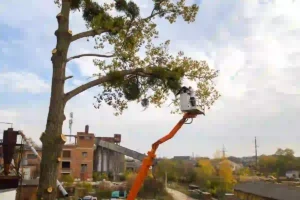Can Trimming a Pine Tree Kill It?
Yes, trimming a pine tree can kill it if done incorrectly. The most common fatal mistakes are removing more than one-third of the foliage in a single year, topping the tree by cutting the central leader, or removing entire branches down to bare wood with no green needles remaining. Pine trees cannot regenerate growth from bare wood the way deciduous trees can. Once you cut past all the green growth on a branch, that branch dies.
Other ways trimming kills pines include pruning during active growth periods when the tree is most vulnerable to stress, making cuts that invite disease or pest infestations, and removing too many lower branches which eliminates the tree’s ability to photosynthesize enough energy to survive.
How Pine Trees Differ from Other Trees
Pine trees and other conifers follow different rules than deciduous trees like oaks or maples or palm trees.
Deciduous trees store energy reserves throughout their entire structure. They can handle aggressive pruning when dormant. Cut a deciduous tree back hard in winter and it’ll usually bounce back with vigorous spring growth.
Pines don’t work this way. Their growth occurs in distinct whorls (circular patterns of branches) that form once per year. New growth happens only at branch tips in areas called candles. Once a branch section matures past the green needle zone, it cannot produce new growth. Ever.
This means every cut on a pine tree is permanent. Remove a branch and no new branch grows back in that spot. Cut into bare wood and that section stays bare forever or dies completely.
Most pines also have shallow root systems compared to deciduous trees. They rely heavily on their full canopy for stability and food production. Remove too much canopy and the tree becomes unstable in wind. It also cannot produce enough food through photosynthesis to maintain its root system and remaining structure.
The One-Third Rule
Never remove more than one-third of a pine tree’s total foliage in a single year.
This is the most important rule for pine tree survival. Break it and the tree goes into shock. It cannot produce enough energy to maintain itself. Root dieback begins. The tree becomes vulnerable to diseases and pests. Death often follows within one to three years.
One-third means total foliage across the entire tree. Not one-third from each branch. If you remove one-third from every branch, you’ve removed way more than one-third of total foliage because of how the math works out.
Visual assessment works better than mathematical calculation. Stand back and look at the entire tree. Imagine it after trimming. Does it still look like a full pine tree with dense foliage? Or does it look sparse and skeleton-like? Sparse means you’ve removed too much.
Professional arborists know this rule. Amateur tree trimmers often don’t. This is why using treetrimmingcostcalculator.com to find qualified tree services matters. The calculator helps identify fair pricing for professional work, and professional work means certified arborists who understand species-specific requirements like the one-third rule for pines.
Topping Kills Pine Trees
Topping means cutting off the top of the tree, removing the central leader.
This is a death sentence for most pine species. The central leader is the main trunk that grows vertically. It controls the tree’s hormonal balance and growth patterns. Remove it and the tree’s entire system gets disrupted.
Some pine species will try to form replacement leaders from lateral branches. But these replacement leaders grow at wrong angles with weak attachment points. They compete with each other. The tree develops structural problems. It becomes unstable and dangerous.
Many pine species won’t even attempt replacement leaders. They simply die slowly from the top down after topping. The process takes one to five years depending on the tree’s health and size.
People top trees to control height. But topped pines either die or become hazardous. If a pine tree is too tall for its location, removal and replacement with an appropriately sized species makes more sense than topping.

Timing Matters for Pine Trimming
The best time to trim most pine species is late winter or early spring before new growth begins.
During this period, pines are dormant or just starting to activate. Trimming stress is minimized. The tree has the full growing season ahead to recover and seal wounds. Diseases and pests are less active in cold weather, so fresh cuts face lower infection risk.
Never trim pines during their active growth period in late spring and early summer. This is when they’re pushing new candles and expanding existing foliage. The tree is directing maximum energy toward growth. Trimming during this period causes severe stress. It also wastes the current year’s growth that you end up removing.
Fall trimming is risky because the tree doesn’t have time to seal wounds before winter. Fresh cuts provide entry points for diseases and moisture that can freeze and cause additional damage.
Some pine species have specific timing requirements based on local pest pressures. In areas with pine bark beetles or other significant pests, local extension offices or certified arborists can advise on optimal timing windows.
Where to Cut on Pine Branches
Only cut pine branches back to lateral branches or back to the trunk.
Never cut into the middle of a branch leaving a stub with no green growth. That stub will die. It becomes a disease entry point. It looks terrible. It serves no function.
When removing an entire branch, cut just outside the branch collar (the swollen area where the branch meets the trunk). Don’t cut flush with the trunk. Don’t leave a long stub. The branch collar contains cells that seal the wound. Cut too close and you remove these protective cells. Cut too far away and you leave dead wood that invites problems.
When shortening a branch, cut back to a lateral branch that’s at least one-third the diameter of the branch you’re removing. Smaller laterals cannot support the remaining branch structure effectively. The branch will likely die back anyway.
Make clean cuts with sharp tools. Ragged cuts from dull tools damage more tissue. They take longer to heal. They’re more vulnerable to infection.
Signs You’ve Over-Trimmed a Pine
Pine trees show specific stress symptoms after excessive trimming.
Needle discoloration appears first. Green needles turn yellow or brown starting from the tips. This happens because the tree cannot supply enough resources to maintain all its foliage with reduced photosynthesis capacity.
Excessive resin flow shows stress. Pines produce resin to seal wounds and defend against pests. Massive resin production means the tree is in crisis mode trying to protect itself. Small amounts of resin at cut sites are normal. Large quantities dripping down the trunk signal problems.
Crown dieback starts at the top or at branch tips. New growth fails to emerge in spring. Existing needles drop excessively. Branches that should be green show bare wood instead.
Pest infestations often follow over-trimming. Stressed trees emit chemical signals that attract bark beetles and other pests. Healthy trees can resist these pests through resin production and other defenses. Stressed trees cannot.
Root decline happens underground where you can’t see it initially. But eventually the tree becomes unstable. It leans. It moves in moderate winds when it should stay stable. This indicates root system failure from lack of energy production.
Common Trimming Mistakes That Kill Pines
Removing all lower branches is a frequent fatal mistake.
People want clear trunk for aesthetics or lawn access. So they remove every branch up to eight or ten feet. This eliminates a huge percentage of the tree’s photosynthesis capacity. Lower branches are often the tree’s oldest and most efficient food producers.
Some lower branch removal is acceptable. But never remove more than one-third of total branches, and never remove more than one-third of the tree’s height in lower branches. A pine with ten feet of bare trunk and only five feet of branches at the top cannot survive long-term.
Shearing pines into geometric shapes often exceeds safe removal limits. The dense outer shell of growth shades and kills interior needles. When you finally cut back into that outer shell, you’re cutting into bare wood with no regenerative capacity. The tree cannot recover.
Removing dead interior branches sounds helpful but can be overdone. Some interior needle loss is natural as the tree matures. Obsessively removing every dead interior twig adds up to significant total foliage loss even though individual pieces seem minor.
Trimming too frequently compounds stress. Pine trees need recovery time between trimming sessions. Trimming every year means the tree is in constant stress mode. It never fully recovers from the previous trimming before experiencing new stress.
Using the wrong tools causes unnecessary damage. Dull saws tear bark. Pruning poles used incorrectly strip needles from remaining branches. Spikes used for climbing injure the trunk in dozens of places.
Species-Specific Considerations
Different pine species tolerate trimming differently.
White pines are relatively forgiving. They can handle moderate pruning and recover reasonably well if you stay within the one-third rule. They’re often used in landscapes specifically because they tolerate management better than other pines.
Scotch pines are less tolerant. They respond poorly to heavy pruning. They’re prone to disease entry through pruning wounds. Conservative trimming only.
Austrian pines and red pines fall somewhere in between. They can handle moderate trimming but show stress from aggressive work.
Longleaf pines have extremely specific requirements. They spend years in a grass stage before developing trunks. Trimming during this period can kill them. Even mature longleaf pines should only be trimmed by specialists familiar with the species.
When getting estimates for pine trimming, ask specifically about the tree service’s experience with your exact pine species. Generic pine trimming knowledge isn’t enough. Species-specific knowledge prevents expensive fatal mistakes.
When Professional Help Is Necessary
Any pine over 15 feet tall needs professional trimming.
Heights above 15 feet require ladders, climbing equipment, or bucket trucks. Improper tool use at these heights causes both safety hazards and tree damage. Falls kill or injure people every year. Poor cuts from unstable positions kill trees.
Pines near power lines require professional work even if they’re shorter. Power line contact can electrocute tree workers. It can cause power outages. Some utilities require their own crews to do work near lines and won’t allow private contractors near high-voltage lines.
Pines showing signs of disease or pest infestation need professional diagnosis before any trimming. Trimming diseased trees can spread disease to healthy trees through contaminated tools. Some diseases spread through fresh pruning wounds during specific times of year.
Large branch removal (branches over three inches diameter) requires proper technique and equipment. Improper large branch removal tears bark, creates large wounds that don’t heal properly, and can cause entire sections of the tree to fail.
Use treetrimmingcostcalculator.com to get baseline pricing for professional pine trimming. Enter your tree height, accessibility details, and zip code. The calculator provides realistic cost estimates based on your specific situation. Small pines under 25 feet typically cost $150-$400 to trim. Medium pines (25-50 feet) run $400-$800. Large pines over 50 feet cost $800-$1,500 or more.
Get written estimates from at least three certified arborists. Compare against the calculator baseline. Verify insurance. Check references. Choose based on qualifications and species-specific knowledge, not just lowest price.
Recovery After Proper Trimming
Even properly trimmed pines need recovery time.
The year following trimming, growth may look sparse. New candles may be smaller than usual. Needle color might be slightly off. This is normal stress response, not a sign of dying.
Provide adequate water during the growing season after trimming. Not excessive water. But maintain consistent soil moisture. Stressed trees need steady resources to recover.
Avoid fertilizing immediately after trimming. Fertilizer pushes growth, which stresses an already stressed tree. Wait until the following year to resume normal fertilization if you fertilize at all.
Monitor for pests and diseases more carefully after trimming. Stressed trees are vulnerable. Catching problems early makes treatment more effective.
Don’t trim again for at least two to three years. The tree needs time to recover fully and restore its energy reserves before handling additional trimming stress.
The Bottom Line
Trimming can kill pine trees when done wrong. The key factors are amount removed (stay under one-third), where you cut (only to laterals or trunk, never leaving bare stubs), timing (late winter/early spring), and frequency (minimum two to three years between sessions).
Professional work from certified arborists who understand pine-specific requirements prevents fatal mistakes. The cost difference between amateur and professional work is minor compared to the cost of losing a mature pine tree and removing the dead tree later.
Pines that receive proper care can live decades or centuries. Pines that receive improper trimming often die within a few years. Taking time to understand proper techniques or hire qualified professionals protects your investment in your landscape.



